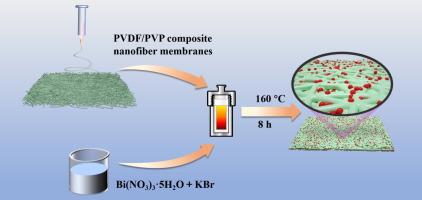Design and performance investigation of novel efficient photocatalysts PVP-modified PVDF/BiOBr photocatalytic membranes for wastewater treatment
IF 13.2
1区 工程技术
Q1 ENGINEERING, CHEMICAL
引用次数: 0
Abstract
Photocatalytic composite membranes (BPMs) are preferred materials for wastewater treatment due to their high photocatalytic activity and ease of recovery. However, conventional blending modification methods for preparing BPMs often lead to drawbacks such as uneven distribution of photocatalysts, low loading efficiency, facile detachment of photocatalysts, poor reusability, and a limited specific surface area of the membranes. These issues significantly diminish their photocatalytic activity and restrict their practical applications. To address these challenges, this thesis introduces a novel preparation method for PVP-modified PVDF/BiOBr photocatalytic membranes, using a combination of electrospinning and solvothermal techniques. This approach enhances the stability of BiOBr microspheres on the PVDF nanofiber membranes, effectively tackling the issue of loading powder photocatalysts. These membranes, composed of PVDF nanofibers and uniformly sized BiOBr microspheres, exhibit a significant specific surface area of 15.69 m2/g. The modified PVDF/BiOBr photocatalytic membranes demonstrate remarkable degradation efficiencies: 100 % degradation of Rhodamine B (RhB) in 25 min, 93.8 % degradation of tetracycline (TC) in 30 min, and 74.6 % degradation of hexavalent chromium ions (Cr6+) in 60 min. Moreover, after five cyclic experiments, the photocatalytic degradation rate of sample M3 remains above 99 % with a minimal loss rate of only 0.5 %. The method developed for preparing PVDF/BiOBr photocatalytic membranes represents a universally applicable and straightforward strategy for fabricating advanced membrane materials. This preparation technique not only provides innovative design ideas and fabrication methods for new photocatalytic materials but also extends to other functional materials. The PVDF/BiOBr photocatalytic membrane materials hold great promise in offering technical and theoretical support for photocatalytic wastewater treatment.

新型高效光催化剂PVDF/BiOBr光催化膜的设计与性能研究
光催化复合膜(bpm)因其高光催化活性和易于回收而成为污水处理的首选材料。然而,传统的共混改性方法制备bpm往往存在光催化剂分布不均匀、负载效率低、光催化剂易脱落、可重复使用性差、膜的比表面积有限等缺点。这些问题大大降低了它们的光催化活性,限制了它们的实际应用。为了解决这些挑战,本文介绍了一种新的制备方法,利用静电纺丝和溶剂热技术相结合的方法来制备pvp改性PVDF/BiOBr光催化膜。该方法提高了BiOBr微球在PVDF纳米纤维膜上的稳定性,有效地解决了粉末光催化剂的负载问题。这些膜由PVDF纳米纤维和均匀尺寸的BiOBr微球组成,具有15.69 m2/g的显著比表面积。改性PVDF/BiOBr光催化膜具有显著的降解效率:25 min对罗丹明B (RhB)的降解率为100% %,30 min对四环素(TC)的降解率为93.8 %,60 min对六价铬离子(Cr6+)的降解率为74.6 %。此外,经过5次循环实验,样品M3的光催化降解率保持在99 %以上,最小损失率仅为0.5 %。所开发的制备PVDF/BiOBr光催化膜的方法代表了一种普遍适用和直接的制造先进膜材料的策略。该制备技术不仅为新型光催化材料提供了创新的设计思路和制造方法,而且还可扩展到其他功能材料。PVDF/BiOBr光催化膜材料为光催化废水处理提供了技术和理论支持。
本文章由计算机程序翻译,如有差异,请以英文原文为准。
求助全文
约1分钟内获得全文
求助全文
来源期刊

Chemical Engineering Journal
工程技术-工程:化工
CiteScore
21.70
自引率
9.30%
发文量
6781
审稿时长
2.4 months
期刊介绍:
The Chemical Engineering Journal is an international research journal that invites contributions of original and novel fundamental research. It aims to provide an international platform for presenting original fundamental research, interpretative reviews, and discussions on new developments in chemical engineering. The journal welcomes papers that describe novel theory and its practical application, as well as those that demonstrate the transfer of techniques from other disciplines. It also welcomes reports on carefully conducted experimental work that is soundly interpreted. The main focus of the journal is on original and rigorous research results that have broad significance. The Catalysis section within the Chemical Engineering Journal focuses specifically on Experimental and Theoretical studies in the fields of heterogeneous catalysis, molecular catalysis, and biocatalysis. These studies have industrial impact on various sectors such as chemicals, energy, materials, foods, healthcare, and environmental protection.
 求助内容:
求助内容: 应助结果提醒方式:
应助结果提醒方式:


